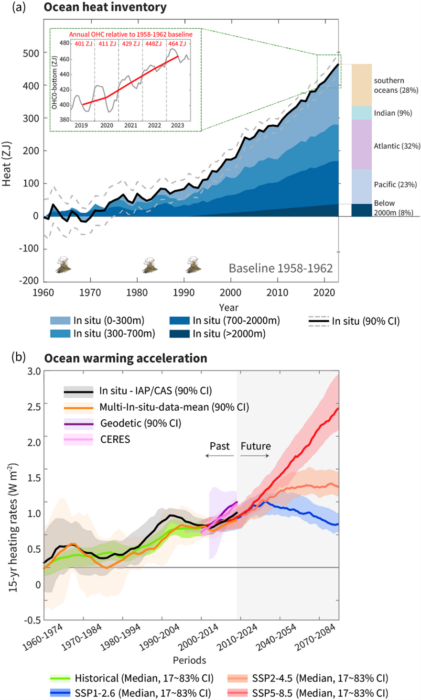A new research paper in Nature Reviews Earth & Environment “Ocean Heat Content in 2023” has provided insight into the worldwide increase of Ocean Heat Content (OHC), which indicates the quantity of energy absorbed by the Ocean at varying depths and locations. The authors, who include Mercator Ocean oceanographers Karina von Schuckmann and Audrey Minière, revealed that OHC reached a record high in 2023, continuing the long-term increase registered since 1960. Ocean Heat Content has been breaking records yearly since 2017. Trends mentioned in the research paper confirm a robust long-term Ocean warming acceleration. The authors insist on the importance of sustained monitoring of such a key parameter to ensure informed decision-making in international climate negotiations.
A new record-high for Ocean Heat Content
Since heat is dispersed at varying rates depending on the Ocean depth, the study details different percentages of heat accumulation at the different layers, with 40%, 24%, 28%, and 8% of heat distributed in the layers 0–300m, 300–700m, 700–2000m and below –2000m respectively. In 2023, heat accumulated more rapidly in the upper layers of the Ocean, where human activities appear to have a greater impact; on the other hand, the deeper layers remained less affected by anthropogenic influences consistent with previous findings.
| Ocean layer | Respective heat accumulation recorded in 2023 |
| 0-300m | 40% |
| 300-700m | 24% |
| 700-2000m | 28% |
| -2000m | 8% |
According to the authors and the recent IPCC assessment report, the long-term trend of OHC increase is largely attributed to anthropogenic causes, such as greenhouse gases emissions and aerosols. OHC variations, however, do not only take place at varying magnitudes depending on depth layers but also according to geographic locations. Indeed, the authors found the strongest heat gain in the Atlantic Ocean and the Southern Ocean, as opposed to the Indian and Pacific Ocean, with the respective deep layers showing major heat accumulation. The authors explained such phenomenon with changes in deep-reaching Ocean circulation and stronger mixing between the Atlantic and Southern Ocean.
Acting as a “heat sink”, the Ocean absorbs approximately 90% of the extra-heat stored in the climate system according to a 2023 study led by Mercator Ocean International; given that 2023 witnessed the highest global surface temperature on record, the authors already anticipated a corresponding record-breaking increase in ocean heat content accumulation.
Ongoing and accelerated heat gain
Another key finding of the study concerns ongoing and accelerated heat gain: while specific numbers differ depending on datasets, time periods and methodological choices used, data generally indicates a robust long-term Ocean warming acceleration. According to the research, an optimistic low-emission scenario foresees this acceleration stopping around 2030 – 2040, while acceleration would persist throughout the twenty-first century in simulations featuring higher emission paths. The acceleration of the Earth system heating was explored more in depth in a 2023 paper by Mercator’s scientists Audrey Minière and Karina von Schuckmann also published in Nature magazine.

Going forward: the importance of Ocean Heat Content monitoring
The warming of the Ocean has already altered the functioning of the marine environment, causing sea level rise, changes in Ocean circulation, melting sea ice and intensifying tropical cyclones and other extreme events.
In the paper, scientists warn about the worsening of ocean warming due to continued global warming and call for a sustained and extended monitoring of OHC accumulation to provide data to support informed decision-making in Ocean and climate negotiations at the international level. The magnitude and pace of warming are intricately tied to socioeconomic scenarios, underscoring the relevance of Ocean Heat Content (OHC) as a metric crucial for policy considerations.
What is Ocean Heat Content?
Ocean Heat Content (OHC) indicates the total amount of heat stored in the Ocean and it is measured in joules, which represent units of energy. The development of improved integrated Ocean observation systems since the 1960s has allowed scientists to produce OHC estimates and identify trends. OHC is calculated at different depths through a series of observation instruments, such as in situ observations (Argo floats deployed by research ships in different parts of the Ocean) or satellite observations as well as model simulations and variations in other key variables. The Copernicus Marine Service of the European Union estimates the Ocean Heat Content down to three depths: 0-300, 0-700 and 0-2000 metres; each depth layer provides different perspectives and data on the overall heat storage in the Ocean. Data about the three indicators can be accessed through the Ocean Climate Portal.
About the authors
The paper is the result of cooperation within an international team of scientists from China, Europe and the United States: Lijing Cheng (Institute of Atmospheric Physics, Chinese Academy of Sciences, Beijing, China), Karina von Schuckmann (Mercator Ocean International), Audrey Minière (Mercator Ocean International), Maria Z. Hakuba (Jet Propulsion Laboratory, California Institute of Technology, Pasadena, CA, USA), Sarah Purkey (Scripps institution of oceanography, La Jolla, USA), Gavin A. Schmidt (Goddard Institute for Space Studies, National Aeronautics and Space Administration, New York City, NY, USA) and Yuying Pan (Institute of Atmospheric Physics, Chinese Academy of Sciences, Beijing, China).
Additional Resources
- Read the research paper
- Read the press release
- Red more about Ocean Heat Content on the Ocean climate portal
- Read MOi’s article on the research paper “Heat stored in the Earth system 1960–2020: where does the energy go?” by Karina von Schuckmann and Audrey Minière

